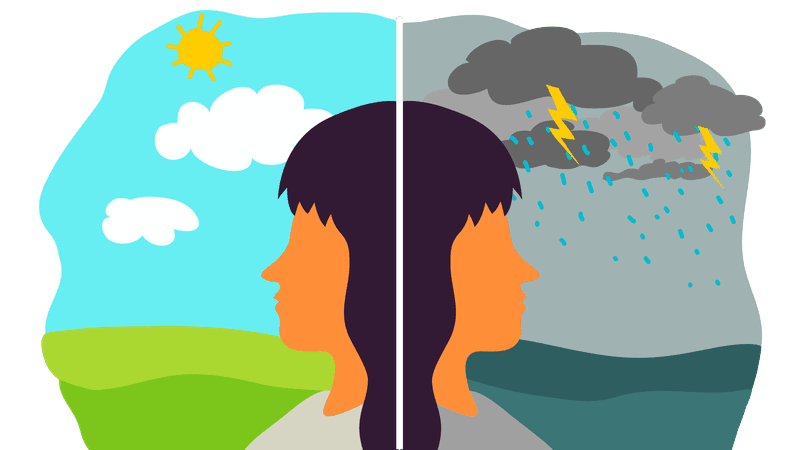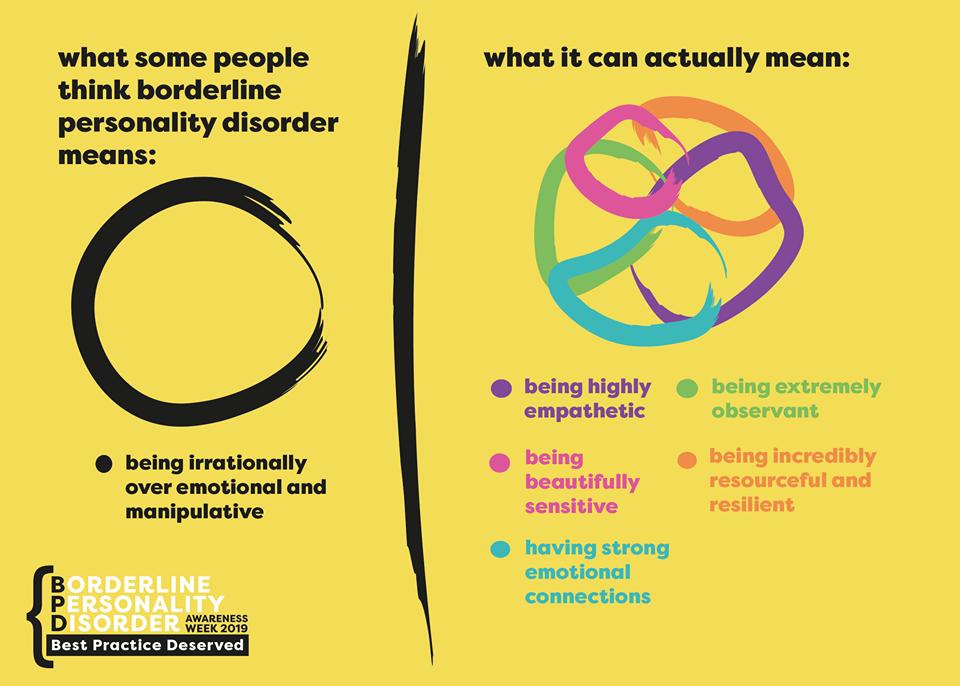Have you ever gotten so angry that you burst into a fit of rage, committing some destructive acts and almost like a blackout, you’re left wondering “What just happened?”
Or maybe a good friend accidentally hurt you or did something that instantly made you devalue and even hate the same friend who was there for you throughout the years.
Maybe you love making decisions on the whim, random tattoos litter your body, and your ears are covered with more metal than skin while your hair could give a rainbow a run for its money.
Most importantly, do you ever fear the end of your relationship so much, you either 1. Abandon them first (can’t get hurt by them if you hurt them first) or 2. Obsessively cling onto them in hopes that will keep them around?
If all this sounds familiar to you, you might have Borderline Personality Disorder.

Borderline Personality Disorder or BPD as it’s typically known as, and is categorized as a Cluster B personality disorder. Cluster B personality disorders are characterized by dramatic, overly emotional, or unpredictable thinking or behaviors. You might be familiar with the other under this term: antisocial personality disorder, borderline personality disorder, narcissistic personality disorder, and histrionic personality disorder.
What Is Borderline Personality Disorder?
As I’ve described earlier, Borderline Personality Disorder is a psychiatric illness according to the Diagnostic and Statistical Manual of Mental Disorders.
The 9 Characteristic Symptoms of BPD
With 9 characteristic symptoms (having 5 of them is enough to be diagnosed with the disorder), BPD patients are said to:
- Have a fear of abandonment (real or imagined)
- Unstable & intense relationships characterized by splitting (seeing things as all-good or all-bad)
- Unstable & intense moods
- Inappropriate & intense anger
- Impulsivity (binge eating, drinking, smoking, reckless driving)
- Chronic emptiness
- Lack of identity/Unstable sense of self
- Suicidal thoughts
- Paranoia/Dissociation
If you see yourself in any of the symptoms, it might be a good idea to get checked with a professional psychiatrist. In the U.S alone, an estimation of 1.6% of their adult population is also diagnosed with BPD so don’t be afraid, you are not alone in this.
Typically BPD patients also have a high chance of being diagnosed with other psychiatric illnesses like:
- Major Depressive Disorder
- Anxiety Disorders
- Eating Disorders
- Bipolar Disorder
- Dissociative Identity Disorder
- Attention Deficit/Hyperactivity Disorder
Just like the illnesses listed, BPD is highly treatable and patients can seek help from medical professionals like psychologists and psychiatrists.
Causes of Borderline Personality Disorder
The causes of BPD is still being debated about. Due to its stigmatization, not many research and studies have been done to better understand the disorder. But from what has been concluded so far is that BPD stems from:
- Stressful and traumatic life experiences
- Genetics
Many professionals have compared BPD as a form of PTSD (Post-Traumatic Syndrome Disorder) and the treatments undergone by both types of patients are very similar.
Stressful and traumatic life experiences don’t even need to be major. As a child or adolescent growing up, anything life-changing can be counted as traumatic. For example, parents’ divorce, death and even just the feeling of being afraid, upset, unsupported and invalidated can lead to BPD.
In the genetics side, siblings, children or even parents of people suffering from BPD are 10 times more likely to have the disease themselves. A recent study has also found that BPD patients have different brain makeup than neurotypical brains. The part of the brain that helps with emotional regulation remains inactive in BPD patients. This might just be an explanation for why BPD patients’ emotions tend to be out of control.
How to Treat Borderline Personality Disorder
Firstly, it must be known that because it’s a personality disorder, medications can only help the patient to a certain extent. This is because it’s a patient’s personality: accumulation of learned traits & behaviors not something with the brain.
So the best bet for recovery is psychotherapy. Basically whatever you see in movies where you lay on a chaise and talk to a professional who might or might not just be scribbling nonsense in their notepad.
But did you know that it’s not just talking (an excuse many uses to shame therapy) as there are different treatments within psychotherapy for different types of patients?
So for patients with BPD,
Dialectical Behavioral Therapy (DBT) is the best form of psychotherapy. It was actually created specifically for BPD patients! It gets its elements from another type of therapy, Cognitive Behavioral Therapy (CBT) which focuses on how thoughts and beliefs can lead to actions and behaviors. Interestingly enough, I have some people described DBT as CBT infused with the teachings of Buddha as mindfulness is a huge component.
A BPD Sufferer Shares With Us Her Journey With BPD

Now that we’ve identified the causes and treatment for BPD, I think it’s much more meaningful to hear a personal account by a real-life sufferer of BPD.
This topic was chosen because BPD inflicts a close friend of mine and we’re both determined to spread awareness on this illness.
If you search up on borderline personality disorder enough, there IS many hate & backlash for BPD patients.
But just like how you wouldn’t shame a cancer patient for being in pain after chemo, we should work to understand these “invisible” diseases more too.
For the majority of the 25 years of her life, Ally* has been suffering from Borderline Personality Disorder. As a kid, she recalls she was always more sensitive and prone to outbursts than others around her. Even a friend forgetting to save a spot during assembly mornings would have made her run into the school’s toilet to sob over a loss of friendship.
Excusing it as typical child dramatics, Ally’s parents didn’t fuss over it. Instead, they used a method that might have fueled her genetic predisposition to BPD even more by either ignoring her tantrums or straight up asking her to “grow up”. Ally doesn’t blame them knowing her parents were just trying their best to keep the family up float financially while dealing with their own marital problems and admittedly she was “not an easy child.”
Ally always knew she was different from the other kids. Whenever something happened to the class, Ally seemed to be more affected and more susceptible to the damage. This includes happiness and joy, almost a manic quality to her reactions.
Eventually, this led to many loss of friendship save for a few true ones who stood by her side. But even then at a young age, Ally learned how to control these emotions or at least hide it sufficiently enough to avoid being called “weird” again.
But chalking it up as being a sensitive child (or an empath as the current generation would call it), Ally didn’t focus on it. She had more fun things to do: like play Barbie with her friends or get good scores in the major exam to go to a good high school…
Which she did. Ally might have been an emotional & tumultuous child but she was smart and had a good head on her shoulders. Which led her to one of the highest-ranking high schools in the state.
However, that’s when more symptoms of the disorder leaked out.
High school is a terrible time for most of us. We’re at the awkward stages of our lives. One day we’re exactly how we look like in primary school then suddenly we’re growing hair in places not on our heads. The boy you found disgusting suddenly makes you tongue-tied. It’s a big messy pile of emotions, body parts and coupled in with education just calls as a breeding ground for mental illnesses.
Ally recalls her first boyfriend and after being dumped by him, she remembers the emotional tirade she went on.
“After getting dumped by him (if you can even call it that), I went on full-blown crazy mode. I had a blog and basically dedicated it to writing about him. It felt like my whole life after that was dedicated to him. And we were only together… for like what, 2 weeks? That’s pretty bad.”
But again, it was easy to chalk it up as being an emotional teenager.
But it became a pattern, Ally told us that throughout the entirety of her high school years, she was in-and-out of relationships.
“The cycle was simple. Date a guy, have a destructive relationship, get dumped, find a new guy, rinse and repeat.”
“I never stayed single for long. Longest was probably less than a year. It was definitely unhealthy. I had friends who never dated at all in high school and I kinda wished I followed their way too.”
So with that said, when did Ally eventually realize something was truly off?
“Well, it started with one of the last boys I dated in high school. Even with the sentence shows how many boys I dated. Ugh. Anyway, our relationship was really, really bad and toxic. And it was the very first time I had outbursts that led to me being emotionally abusive to the guy.
Now, it’s not like previous relationships were all sunshine and rainbows but this one really took the cake. It was normal to have a screaming match between both of us at not even 12 pm every day. And somehow someway I stumbled upon “BPD” on Tumblr.
Everything clicked, you know? All the symptoms, all the reactions BPD patients matched mine completely. And the only reason why it was so apparent in my relationship with that guy was that he was the only one who bothered to point my toxic behaviors out.
And after reading up more about BPD, I decided to visit a professional. I went to a psychologist first for a few months. I never brought the disease up, not wanting to cause any biasness.
But eventually, she referred me to a psychiatrist and he immediately diagnosed me with BPD and well, here we are.
I had been prescribed antidepressant medication and continue to see my psychologist. Sometimes I have things under control and sometimes I still have an outburst.
But just like most things in life, nothing’s consistent and as long as I keep trying, I know I’ve tried my best in fighting this disorder.”
Like this article? Read about getting mental health help in Malaysia. These articles (including the one you’re reading right now) are all under Teh Talk Taboo series where we shed light on subjects that Malaysians find taboo.



